I already took a look at the Radeon RX 7800 XT reference card this morning so we have an idea of how the new 7800 XT GPU performs. But most people aren’t picking up the stock-clocked reference cards, they run the partner cards with larger coolers and are overclocked. To get an idea of how the 7800 XT performs in that situation, XFX sent over their Merc 319 7800 XT Black. I’ve been a fan of XFX’s clean styling for the last few generations, they haven’t done the standard “gaming” styling that packs a bunch of angles into the design with multiple shades of grey. They have simple smooth fan shrouds and stick mostly with black. I’m hoping that the Merc 319 7800 XT Black is going to continue that. So let’s dive in and see what the Merc 319 7800 XT Black is all about and how it performs.
Product Name: XFX Merc 319 7800 XT Black
Review Sample Provided by: XFX
Written by: Wes Compton
Amazon Affiliate Link: HERE
AMDs new RX 7700 XT and 7800 XT
At Gamescom this year AMD announced two new GPUs to fill in a few big gaps in their current 7000 Series GPU lineup. Before the announcement, they had the RX 7600, RX 7900 XT, and RX 7900 XTX. That covered the higher end of the market with their 4K focused cards and the 7600 which is a mid-range 1080p focused card. The two new models fit in the middle with a 1440p resolution focus. While 1080p is still the most widely used resolution on Steam hardware surveys, the 1440p resolution is growing quickly, AMD highlighted this in the presentation pointing out a 44% growth year on year on the Steam hardware survey.
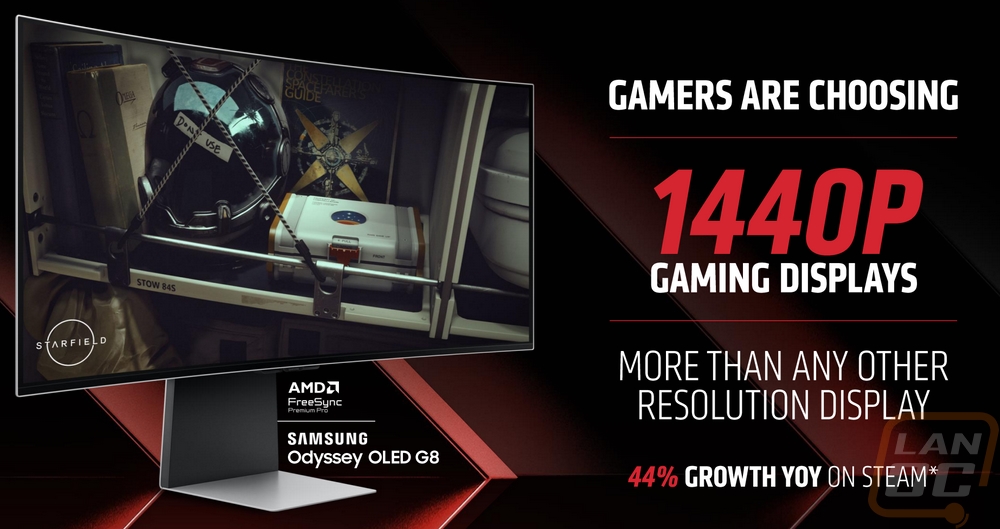
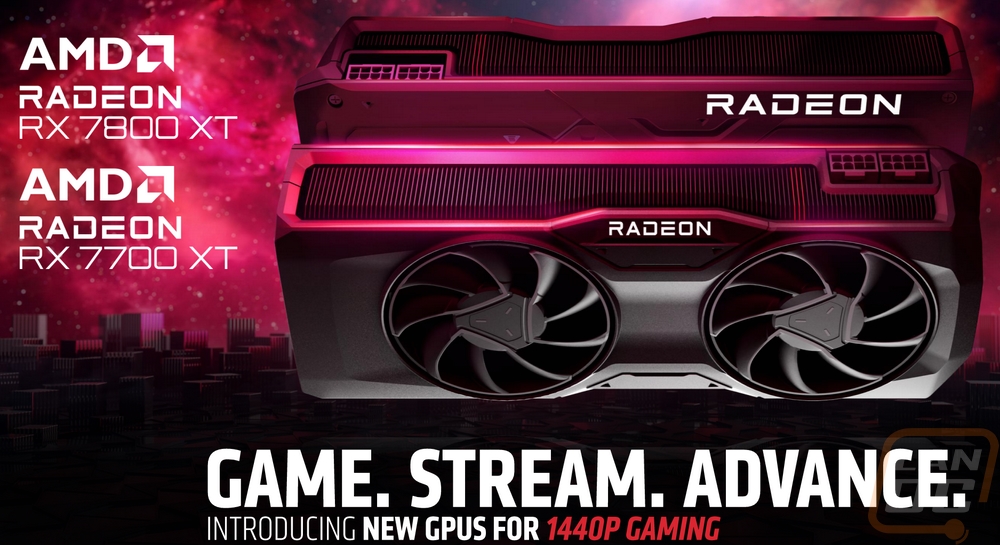
To get a look at where the new RX 7700 XT and RX 7800 XT sit spec wise I have the specs from the AMD briefing as well as a full breakdown that includes the RX 7600 and RX 7900 XT which for the 7000 Series sit above and below the two cards as well as the RX 6700 XT and RX 6800 which are the comparable cards from last generation. Both the 7700 XT and the 7800 XT have the same 5nm and 6nm combination of manufacturing process that the 7900 XT has. The two GPUs have the same die size and transistor count with them sharing the same base GPU but the compute units and the stream processor counts show us that it has been cut down slightly for the 7700 XT compared to the 7800 XT. The 7800 XT is right with the 6800 in stream processors as well as compute units and ray accelerators but last generation's cards didn’t have the AI accelerators which the 7800 XT has 120 and the 7700 XT has 108. The 7800 XT has a slightly lower game GPU clock than the 7700 XT with it at 2124 MHz to 2171 MHz on the 7700 XT. The same goes for the boost clock which the 7800 XT can see up to 2430 MHz whereas the 7700 XT can do up to 2544 MHz. The single precision performance numbers give us an idea of what the lower clock speeds but higher core counts translate to. The 7700 XT can do up to 35 TFLOPS whereas the 7800 XT is slightly higher at 37 TFLOPS. The 7900 XT is way out ahead of that at 51 TFLOPS and the 7600 is well below the two at 21 TFLOPS. Then both the 6700 XT and the 6800 are well below the 7600 at 13.21 TFLOPS and 16.17 TFLOPS.
The 7700 XT has 48 MB of the 2nd generation Infinity Cache whereas the 7800 XT has 64 MB. Then for memory, the 7700 XT has 12GB of GDDR6 memory to the 16GB on the 7800 XT. They also have different memory bus interfaces with a 192-bit interface for the 7700 XT and 256-bit for the 7800 XT and the memory on the 7800 XT is also clocked faster with it running at 19.5 Gbps and 18 Gbps for the 7700 XT. Overall the higher cache and everything else translates to the 7700 XT having an effective memory bandwidth of 1995.3 GB/s to the 2708.4 GB/s for the 7800 XT. Both cards have a traditional PCIe 4.0 x16 interface, not the x8 that the RX 7600 had. Then for power, the two cards do have different total board power ratings with the 7700 XT at 245 watts and the 7800 XT at 263 watts. AMD also announced the base pricing of the cards at Gamescom with the RX 7700 XT at $449 and the RX 7800 XT at $499. The 7800 XT is available in a reference design directly from AMD as well as designs from their partners but the 7700 XT doesn’t have a reference design and will only be available with the partner designs.
|
Specifications |
RX 7600 |
RX 6700 XT |
RX 7700 XT |
RX 6800 |
RX 7800 XT |
RX 7900 XT |
|
Architecture |
RDNA 3 |
RDNA 2 |
RDNA 3 |
RDNA 2 |
RDNA 3 |
RDNA 3 |
|
Manufacturing Process |
6nm |
7nm |
5nm GCD + 6nm MCD |
7nm |
5nm GCD + 6nm MCD |
5nm GCD + 6nm MCD |
|
Transistor Count |
13.3 Billion |
17.2 Billion |
28.1 Billion |
26.8 Billion |
28.1 Billion |
57.7 Billion |
|
Dia Size |
204 mm² |
335 mm² |
200mm² GCD 150mm² MCD |
520 mm² |
200mm² GCD 150mm² MCD |
529 mm² |
|
Compute Units |
32 |
40 |
54 |
60 |
60 |
84 |
|
Ray Accelerators |
32 |
40 |
54 |
60 |
60 |
84 |
|
AI Accelerators |
64 |
-- |
108 |
-- |
120 |
168 |
|
Stream Processors |
2048 |
2560 |
3456 |
3840 |
3840 |
5376 |
|
Game GPU Clock |
2250 MHz |
2424 MHz |
2171 MHZ |
1815 MHZ |
2124 MHz |
2025 MHz |
|
Boost GPU Clock |
Up to 2655 MHz |
Up to 2581 MHz |
Up to 2544 MHz |
Up to 2105 MHz |
Up to 2430 MHz |
Up to 2394 MHz |
|
Peak Single Precision Perf. |
Up to 21 TFLOPS |
Up to 13.21 TFLOPS |
Up to 35 TFLOPS |
Up to 16.17 TFLOPS |
Up to 37 TFLOPS |
Up to 51 TFLOPS |
|
Peak Half Precision Perf. |
Up to 43 TFLOPS |
Up to 26.43 TFLOPS |
Up to 70 TFLOPS |
Up to 32.33 TFLOPS |
Up to 74 TFLOPS |
Up to 103 TFLOPS |
|
Peak Texture Fill-Rate |
Up to 339 GT/s |
Up to 413 GT/s |
Up to 550 GT/s |
Up to 505.2 GT/s |
Up to 583 GT/s |
Up to 804 GT/s |
|
ROPs |
64 |
64 |
96 |
64 |
96 |
192 |
|
Peak Pixel Fill-Rate |
Up to 169 GP/s |
Up to 165.2 GP/s |
Up to 244 GP/s |
Up to 202.1 GP/s |
Up to 233 GP/s |
Up to 459 GP/s |
|
AMD Infinity Cache |
32 MB (2nd Gen) |
96 MB (1st Gen) |
48 MB (2nd Gen) |
128 MB (1st Gen) |
64 MB (2nd Gen) |
80 MB (2nd Gen) |
|
Memory |
8GB GDDR6 |
12GB GDDR6 |
12GB GDDR6 |
16GB GDDR6 |
16GB GDDR6 |
20GB GDDR6 |
|
Memory Speed |
18 Gbps |
16 Gbps |
18 Gbps |
16 Gbps |
19.5 Gbps |
20 Gbps |
|
Effective Memory Bandwidth w/AMD Infinity Cache |
Up to 476.9 GB/s |
Up to 1278.0 GB/s |
Up to 1995.3 GB/s |
Up to 1664.2 GB/s |
Up to 2708.4 GB/s |
Up to 2900 GB/s |
|
Memory Bus Interface |
128-bit |
256*bit |
192-bit |
256-bit |
256-bit |
320-bit |
|
PCIe Interface |
PCIe 4.0 x8 |
PCIe 4.0 x16 |
PCIe 4.0 x16 |
PCIe 4.0 x16 |
PCIe 4.0 x16 |
PCIe 4.0 x16 |
|
Total Board Power |
165W |
230W |
245W |
250W |
263W |
300W |
|
Launch MSRP |
$269 |
$479 |
$449 |
$649 |
$499 |
$899 |
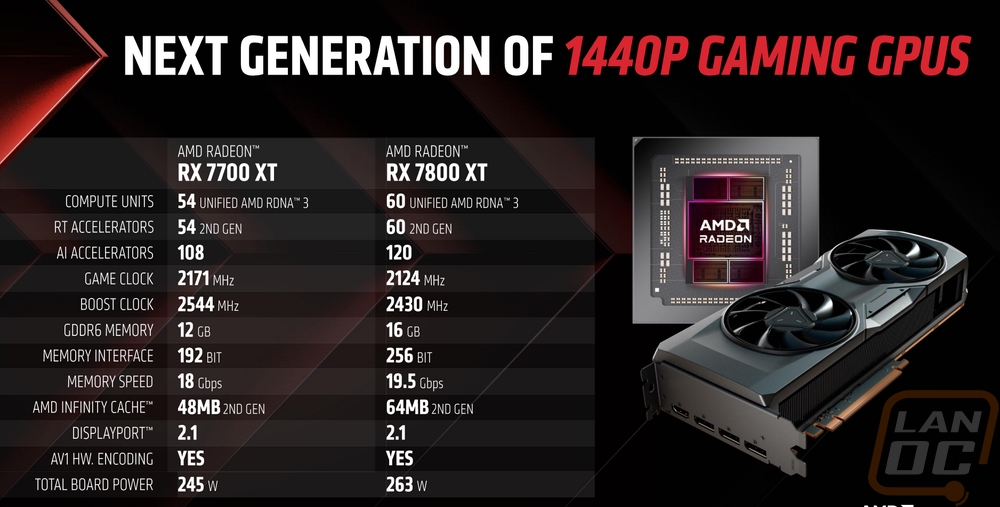
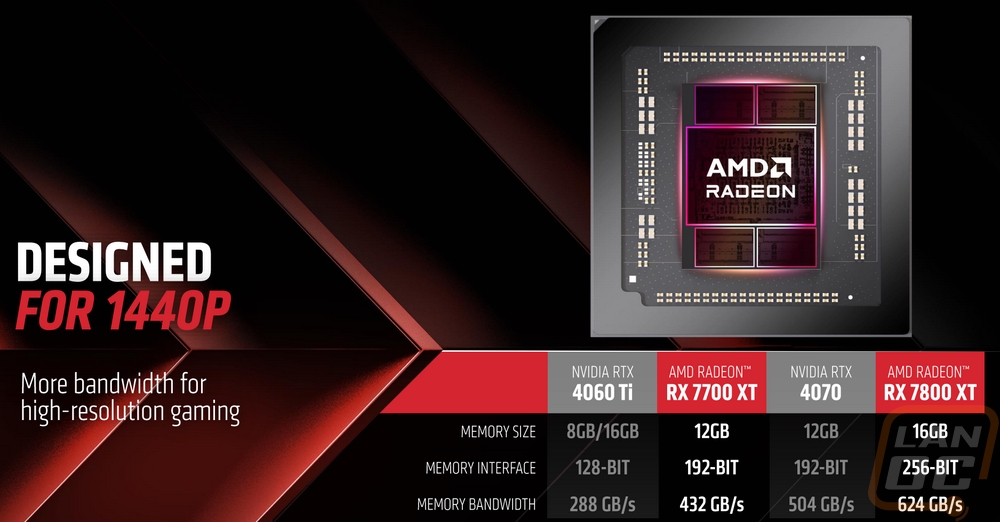
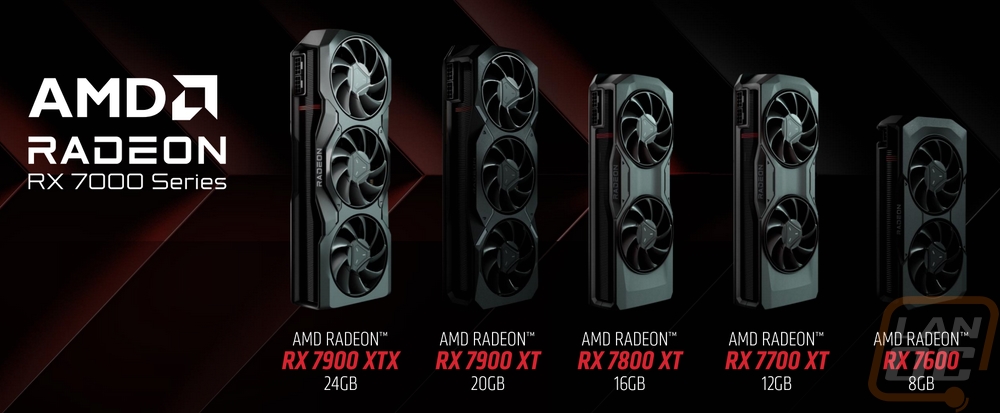
Alongside of the two new cards, AMD also announced their FidelityFX Super Resolution 3 which brings frame generation to AMD cards. Unlike DLSS from Nvidia AMD has this as an open standard so it can not only work with all of AMDs cards, but it can also work with Nvidia cards as well. FSP 3 with upscaling can work with AMD cards back to the RX 590 and Nvidia 10 Series cards but that doesn’t include frame generation. For that, you will need an AMD 5700 or better and RTX 20 Series or higher. They showed off the performance differences that you can see with Forspoken from Square Enix where they were able to go from 36 FPS up to 122 FPS at 4K by using FSR 3 performance mode. FSR 3 has a list of upcoming games and game support of course will make or break this as a feature. The performance is great, but if none of the games you play support It, well that doesn’t help at all. FSR and FSR 2 have 300 games with current or upcoming support so if that is any indication. They also have combined Radeon Boost, Anti-Lag+, and Super Resolution on the driver side into one feature they are calling Hyper-RX which helps make getting better performance easier, with that they showed off some performance improvements you can see with average FPS improving and latency dropping by big margins in all of the games shown.
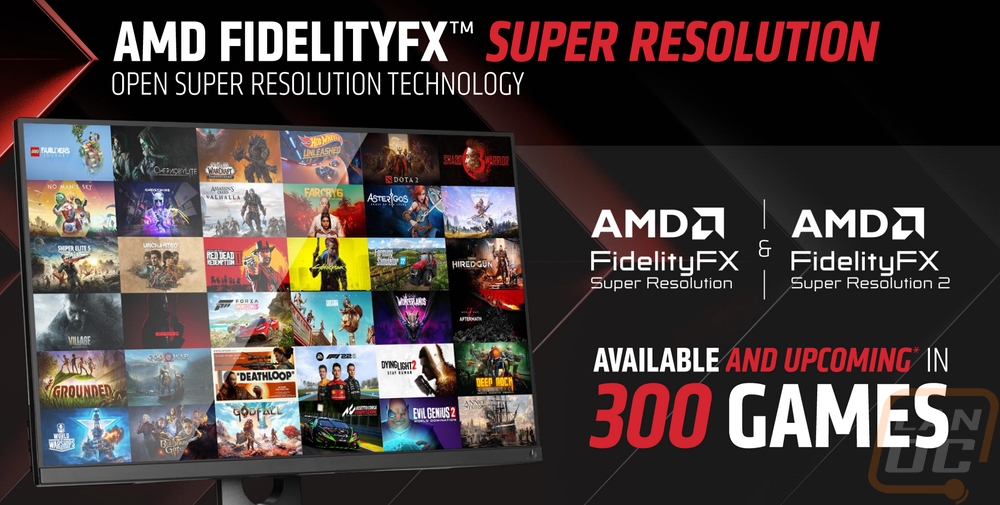
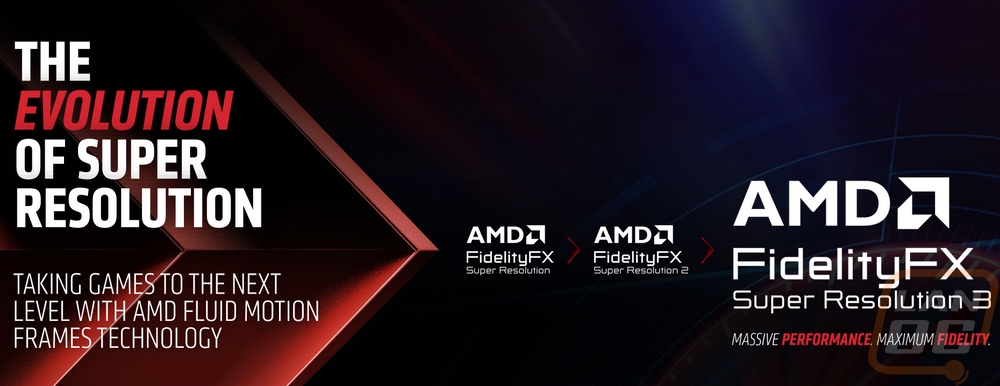
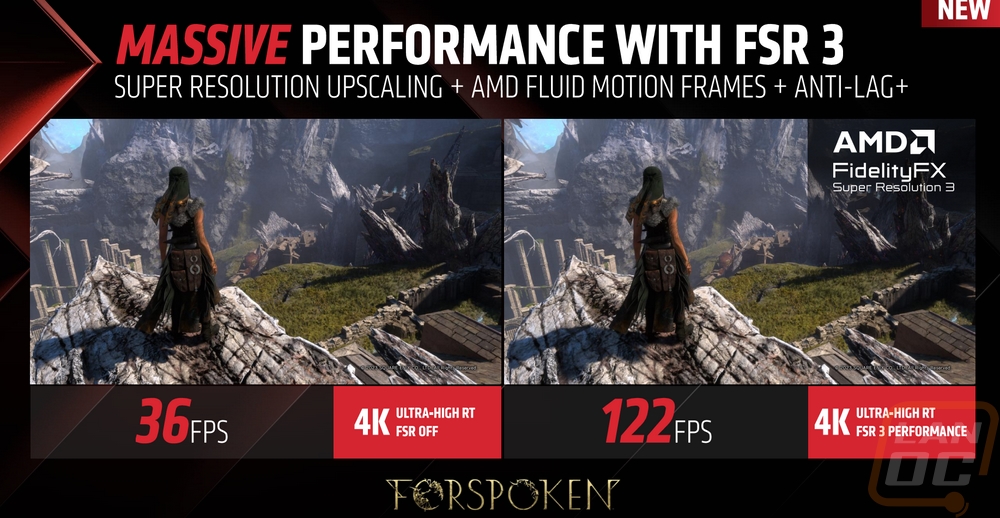
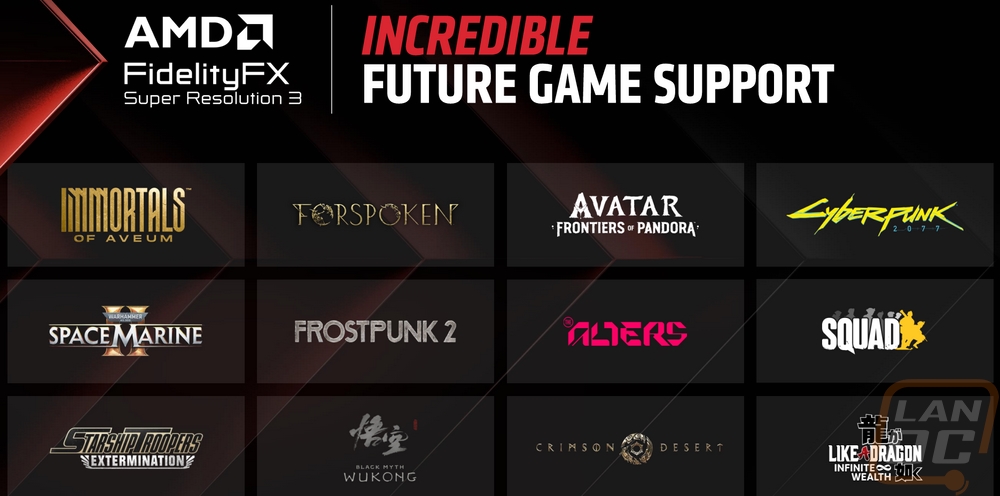
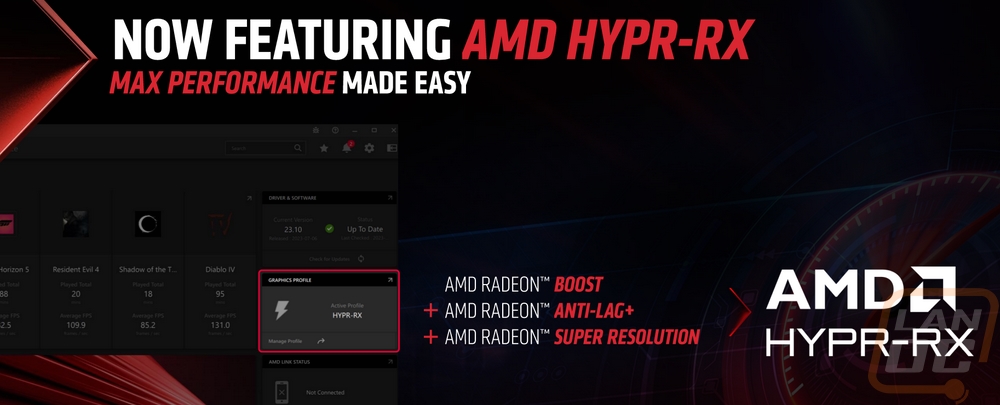
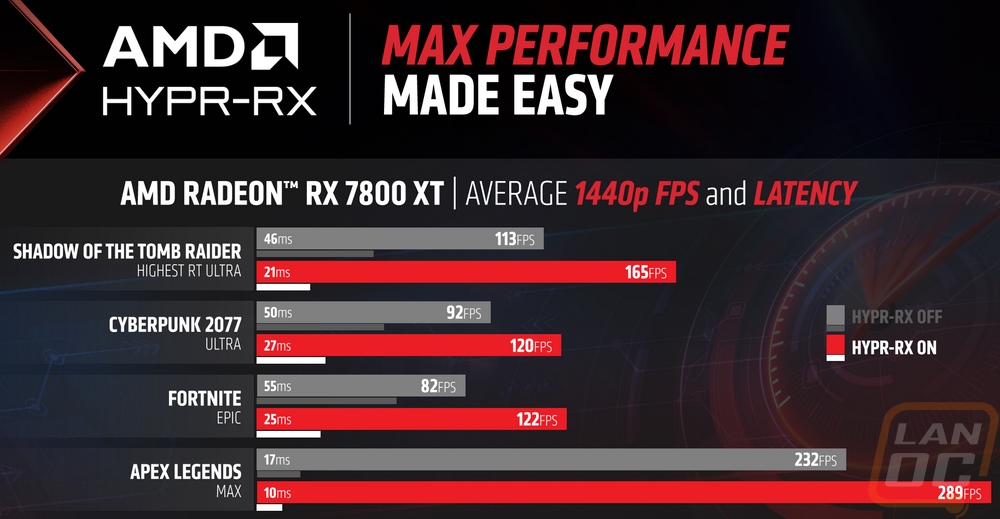
AMD also touched on the streaming capabilities as well on their call. Highlighting AV1 support which is the future of streaming. AV1 can get you higher quality while lowering the bandwidth needs. They also touched on AMDs noise suppression which can help cut out background noise from your microphone.
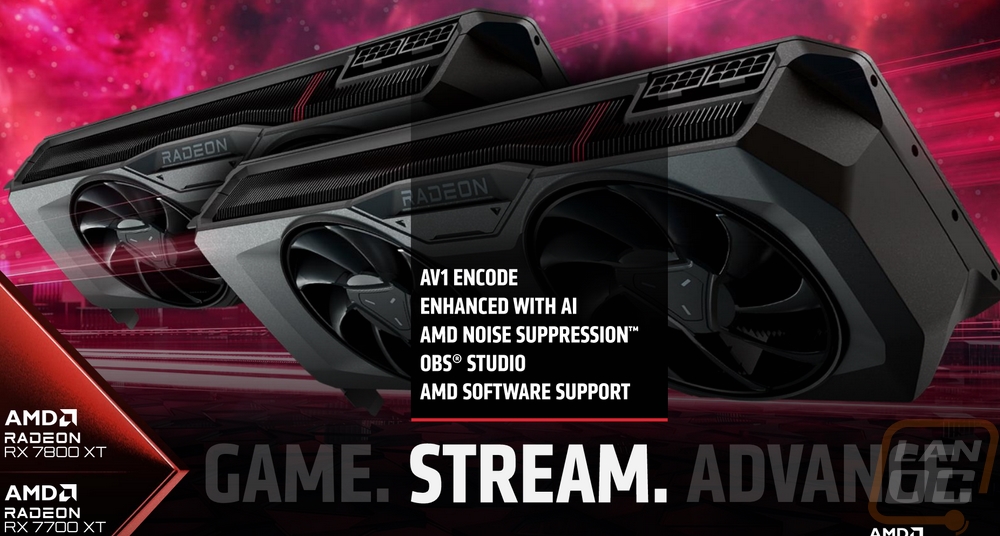
With the RX 7700 XT and RX 7800 XT hitting stores tomorrow September 6th, the cards are also timed to launch the same day as Starfield which utilizes AMDs technology. AMD is also offering a copy of the game to anyone who picks up the 7700 XT or the 7800 XT. This is a great way to add some value to the cards and also make sure everyone has access to a brand new game to check out how your new cards can perform.
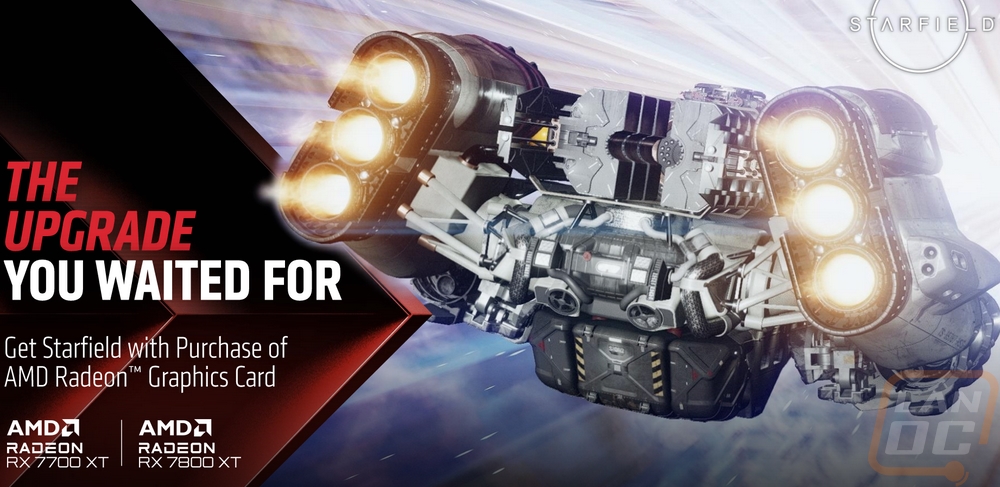
Before getting into testing I did also run GPUz to double-check that our clock speeds matched up with the specifications. The Radeon RX 7800 XT I previous took a look at had the stock clock speed of 2124 default and 2430 MHz for the boost clock. The XFX Merc 319 7800 XT Black is however is overclocked and with that, its boost clock speed is 2565 MHz and the game clock is 2254 MHz which is spot on. This does also document the driver I tested on which is the Adrenalin 23.20.01.05 driver that AMD sent out ahead of the launch and it documents the BIOS revision as well.

|
XFX Merc 319 7800 XT Black Specifications |
|
|
Model Number |
RX-78TMERCB9 |
|
Product Description |
XFX SPEEDSTER MERC319 RADEON RX 7800 XT BLACK Gaming Graphics Card with 16GB GDDR6 HDMI 3xDP, AMD RDNATM 3 |
|
Card Dimension (cm) |
32.6 x12.6 x5.8 |
|
Card Dimension (inch) |
12.83 x 4.96 x 2.28 |
|
Card Profile |
2.75 Slot |
|
DUAL BIOS Setting |
Right: OC: 236w Factory Default Setting Game Clk: up to 2254MHz Boost Clk: up to 2565MHz Note: Right BIOS is the position closest to I/O shield. Left: OC: 236w Backup Bios Game Clk: up to 2254MHz Boost Clk: up to 2565MHz Note: There is no difference in BIOS positions at this time |
|
Thermal Solution |
3 Fan w/ Vapor Chamber |
|
Memory Type |
GDDR6 |
|
Memory Size |
16 GB |
|
Memory Clock |
19.5 Gbps |
|
Memory Bus |
256 bit |
|
Compute Units |
60 |
|
Stream Processors |
3840 |
|
Bus Type |
PCI-E 4.0 |
|
TGP |
236w |
|
Warranty |
3 Years with product registration |
Packaging
The packaging for the Merc 319 7800 XT Black has a vertical orientation which is unique when compared to what all of the other AMD partners do. You used to mostly see this from EVGA on the Nvidia side but they are no longer around. I like the design though, it cuts down the size of the required AMD wrap-around at the bottom as well. That wrap-around puts the 12GB of VRAM in the bottom left corner and the 7800 XT model information in the bottom right. XFX has their logo in the top left, and then the Merc 319 branding covers most of the box with the Speedster designation that can be seen in the background on the black background. Having the smaller wrap-around helps on the back of the box as well because the wrap-around includes AMD-specific features on it down at the bottom. This leaves room for huge pictures of the card from two different angles that cover most of the back. I kind of wish the card pictures were on the front though. They do a good job of showing off the styling and you can see both the fan size and the backplate. The only thing missing are some basic specifications like the card dimensions to make shopping in retail easier.


The outer box sides off and inside there is a main black cardboard box. When you flip the top on that box there is an insert with QR codes for the installation guide, warranty, and drivers. You also have a copy of the card information sticker with your serial number on it which is great if you ever have issues and need to contact support. The insert also has the XFX X logo across it. Under the insert you will find an inch thick foam panel and under that the Merc 319 7800 XT Black is wrapped up in a thick plastic bag. The bag is still semi-transparent so when you dive in you do get to check the card out. The card sits in a thick foam tray that has been cut perfectly to fit it and keep it from moving around. The card also comes with plastic on the entire fan shroud and the backplate giving it double protection from any scratches or wear.



Card Layout and Photos
The Merc 319 7800 XT Black shares the same styling that XFX used on the Merc 319 7900 XT Black and on their 6000 Series Merc cards as well. The fan shroud design is extremely simple, it has a flat black finish and the length of the card is flat, without any of the crazy angles and styling that most cards add to look “gamer”. The only styling that XFX has gone with are silver accents around each of the three fans and silver along the ends of the shroud as well. It’s a lot like a tuxedo, it is simple and clean and never goes out of style. They also don’t have any XFX branding on the fan side of the card or the back really with just the one XFX logo up on the top edge. Too many companies these days are trying to pack their logo all over the place. I guess they do also have the XFX printed on the PCB down at the PCIe connection but that isn’t going to be visible at all.


The Merc 319 7800 XT Black is a huge card, there isn’t any getting around that, especially coming from the reference 7800 relatively compact XT by sticking with the old “standard” high-end GPU size. The Merc 319 7800 XT Black on the other hand is a lot like all of the cards from the last two generations. It is 12.83 inches long or 326 mm long. It goes over the standard PCI height by 21 mm with its 4.96 inch or 126 mm tall design and it is 2.28 inches thick or 58mm which is just a hair under a full triple slot width. I’m surprised we don’t see more of the thicker cards like this use a larger triple-slot PCI bracket for additional support. The overall size is close to what we saw on the Merc 319 7900 XT Black, but the 7900 XT was a little thinner and longer by 18mm.



The triple fan configuration has two larger 100 mm fans on both ends and then a smaller 90 mm fan in the center. The 100 mm fans are 96 mm tip-to-tip and the 90 mm fan is 86 mm tip-to-tip, both fans are 15 mm thick as well. All three are 13-blade fans and are axial, blowing down into the heatsink for cooling. The fans also have auto-stop enabled and will turn off below 50c to keep things quiet. I am surprised that the XFX fan design doesn’t integrate the outer ring for strength that almost all of the GPU fans are using these days, this design is more of a traditional design. They are black and for the centers, they have a black and silver accent. Looking down through the fans gives us a look at the vertically arranged heatsink design which uses aluminum heatsink fins. XFX has a unique alternating fin height design that they are using to help pull more air in through the heatsink. I’m told in total the Merc 319 7800 XT Black has 829007 mm ² surface area.





Up on the top edge, both the fan shroud and the backplate wrap around in different areas. The backplate has a lip that has the Radeon branding printed on it. Then down at the end of the card, the fan shroud has the XFX logo which is also backlit in white. Also on the top edge is of course the power connections and like with the reference card the Merc 319 7800 XT Black has two 8-pin PCIe power connections. This means that you don’t have to worry about a 12VHPWR adapter or new ATX 3.0 power supply just yet to power the Merc 319 7800 XT Black. The power plugs are at the end of the PCB, everything beyond that is part of the blow-through heatsink design. Then up towards the front edge on the PCB XFX does have a dual BIOS switch but at least on our sample they only have the one profile programed to both, I’m unsure if they plan on changing that in the future with a quiet profile or one that uses more or less power. But right now you at least have a backup BIOS which should be great for overclockers.




Looking around at the edges of the card we can learn a little more about the cooling setup. The end of the card for example is mostly covered with a large wrap-around flap from the backplate, it doesn’t have the screw holes that most cards have that you can use for extra support however. The top and bottom show that the plastic fan shroud has the same amount of wrap around on both sides but only the top has the backplate wrapped around on it at all. The cooler is designed to push its airflow out the bottom and top of the card and both are mostly open for that. The bottom view also gives us a peak at the vapor chamber design which is made of copper and nickel plated. XFX has a total of 10 thermal pads between the heatsink and the PCB here, in addition to the 4 for the backplate. The heatsink does a great job of being shorter in the areas needed without wasting any space. Down inside of the heatsink, it has 5 6 mm heatpipes that run down on top of the vapor chamber and then across the card. For power circuitry XFX went with 15-phase full digital PWM and they are MP87997C DrMos chips for the Mosfets and MP2856 for the PWM.





The silver trim around the fan shroud matches with the all silver finish that XFX has gone with for the backplate. The backplate on the Merc 319 7800 XT Black is die-cast aluminum and XFX uses the thick design as a heatspreader with thermal pads between it and the back of the PCB. It does run the length of the card and wraps around along the top edge as well as on the end which help give it even more strength. But even without that, the 2.4mm thickness is going to help keep the card from sagging. Down at the end behind the last fan XFX has cut in a D-shaped opening which exposes the heatsink and allows air to blow through. There are also slots cut in just under the power plugs for ventilation as well as above the GPU and near the PCI bracket on the end. The entire backplate has vertical groves in it which give it a little more surface area and style. There is one small sticker with your model and serial number printed on it. Then up near the top for the power plugs and the BIOS switch they have dropped the height down in those areas to give access to them.


For display connections, the Merc 319 7800 XT Black has the same four connections that the reference card had. You get three DisplayPort 2.1 connections and one HDMI 2.1 connection. The HDMI is up at the top near the mounting ears on the PCI bracket, this is a lot better than in the past where the MDI would just be in the middle of the DisplayPorts making it hard to blindly plug things in. While the heatsink isn’t designed to push any air in this direction the PCI bracket does have ventilation slots in it, the XFX logo was also integrated into them. The bracket itself has a tinted metal finish. I do think a black bracket would go well with the Merc 319 7800 XT Black design, but with the black and silver, this matches as well.

Getting the Merc 319 7800 XT Black next to the Radeon RX 7800 XT reference card from AMD really puts the size difference between the two into perspective. The Merc 319 7800 XT Black is a big card in every sense of the word. If you look closely though you can see that they do have a similar PCB length, but XFX takes advantage of that to have the blow-through section for the last fan.

The XFX logo on the top edge of the card is backlit, so I did also get a picture of it lit up. XFX has kept things simple, the logo is backlit white and doesn’t have any RGB lighting. As a whole I’m not a big fan of backlit logos, it can start to make your PC look like Times Square, but I do think that the logo being in white is about as good as you can get. That said I would still prefer some simple styling accents that are backlit rather than the branding.

Test Rig and Procedures
CPU: Intel Core-i9 13900K – Live Pricing
PL1=PL2: 253, τ: 56 / 307A
Motherboard: Asus Z790 Extreme – Live Pricing
Cooling: Corsair H100i Elite LCD Display - Live Pricing
Noctua NT-H1 Thermal Paste - Live Pricing
Memory: Crucial 32GB Kit (2 x 16GB) DDR5-5600 UDIMM– Live Pricing
Storage: Sabrent Rocket Q4 2TB – Live Pricing
Power Supply: be quiet! Dark Power Pro 13 1600W- Live Pricing
Case: Primochill Wetbench - Live Pricing
OS: Windows 11 Pro 64-bit - Live Pricing
|
Our Testing Procedures |
|
|
3DMark |
All 3DMark-based tests are done using the most recent version. We test using all three versions of Fire Strike, Both Time Spy and Time Spy Extreme, and Speed Way. Tests to look at ray tracing performance are done with Port Royal when supported and for Nvidia cards that support DLSS, the DLSS subtest is also done at 1440p with the performance setting and DLSS 2.0 as well as a look at DLSS 1, 2, and 3 at 4K. |
|
Unigine Superposition |
1080p Extreme and 4k Optimized benchmarks along with the VR Future test are done. The VR test is done at the Oculus resolution |
|
VRMark |
Only the Blue room test is run |
|
CS:GO |
This test is done using the workshop map called CS:GO Benchmark. You can find more information at this link. https://www.gamingpcbuilder.com/how-to-install-csgo-fps-benchmark-map/ I test at 1080p, 1440p, and 4K resolutions. All auto settings are turned off and detail is set to their highest settings. shadow quality high, model texture detail high, shader detail very high, AA set to 16x, uber shaders enabled |
|
Ghost Recon Breakpoint |
Built-in benchmark tested at 1080p, 1440p, and 4k with the Ultra and Medium detail settings |
|
Watch Dogs: Legion |
Built-in benchmark testing at ultra and high details. Tested at 1080p, 1440p, and 4k. I also do RTX and DLSS testing on Nvidia cards at 4K using the Ultra detail settings as a base as well. |
|
Borderlands 3 |
Built-in benchmark testing with the ultra detail setting and medium detail setting, done at full screen with default settings at 1080p, 1440p, and 4k on DX11 |
|
Metro Exodus |
Using built-in benchmark, testing at ultra and normal details at 1080p, 1440p, and 4k. I also do RTX and DLSS testing at 4K with the ultra-detail base settings for Nvidia cards as well. |
|
World War Z Aftermath |
Built-in benchmark in DX11 testing both the Ultra detail and Medium detail levels at 1080p, 1440p, and 4K resolutions |
|
The Division 2 |
Built-in benchmark at Ultra detail with V-Sync turned off at 1080p, 1440p, and 4k resolutions. |
|
Total War: Three Kingdoms |
Built-in benchmark using the Battle Benchmark setting. Tested at 1080p, 1440p, and 4k at both high and ultra detail settings |
|
Far Cry 6 |
Built-in benchmark tested at 1080p, 1440p, and 4k with the Ultra and Medium detail settings |
|
V-Ray 5 |
V-Ray 5 benchmark us run with CUDA and RTX settings on cards that support it |
|
Boundary Benchmark |
Testing different DLSS detail levels on cards that support it. All testing is done at 4k with RTX on |
|
Bright Memory Infinite RTX Benchmark |
Benchmark all of the different RTX detail levels. Resolution at 4k and DLSS on balanced for each test |
|
Passmark Performance Test 10.2 |
Test using the GPU Compute Score inside of PassMark's Performance Test 10.2 |
|
Blender |
Using the standard Blender Benchmark I run the test using the Blender 3.4 setting which tests using the Monster, Junkshop, and Classroom tests. |
|
OctaneBench 2020.1 |
OctaneBench is designed to test rendering in OctaneRender. RTX and non-RTX are both ran. This is a CUDA-only test so only Nvidia cards are tested |
|
Power Testing |
Using a PCat v2 to monitor power between the PCIe slot and the card as well as power through the power cables I test the peak power when running ADIA64, 3DMark Speed Way, 3DMark Time Spy Extreme, FarCry 6 at 4k and Ultra Detail, Watch Dogs Legion at 4K and Ultra detail, and Blender 3.4.0. The results are then averaged as well as the highest result. |
|
Noise Testing |
Our Noise testing is done using a decibel meter 18 inches away from the video card on the bottom/fan side of the card. We test at 50% and 100% fan speeds as well as a third test while under load using AIDA64's stress test. This is done using a Protmex PT02 Sound Meter that is rated IEC651 type 2 and ANSI S1.4 type 2. Tests are done set weighted to A and set to a slow response using the max function. The ambient noise level in the testing area is 33.3 decibels. |
|
Temperature Testing |
Using AIDA64, the GPU stress test is run for 30 minutes or until the result has leveled off. The test is run twice, once with the stock fan profile and a second time with 100% fan speed. During this, I also document the 100% fan speed RPM and document the delta between the fan profile and 100% fan speed as well as get thermal images. |
Synthetic Benchmarks
As always I like to start my testing with a few synthetic benchmarks. 3DMark especially is one of my favorites because it is very optimized in both Nvidia and AMD drivers. It's nice to not have to worry about it being favored too much either way and the repeatability of the results makes it a nice chance to compare from card to card, especially when comparing with the same GPU. For the Merc 319 7800 XT Black, we have already taken a look at the reference Radeon RX 7800 XT, and with that, I am excited to see how the overclock that XFX has given this card will affect performance. Especially with our reference testing seeing the overclocked XFX 6800 XT ahead of the 7800 XT, it will be interesting to see if the Merc 319 7800 XT Black can catch up. The Merc 319 7800 XT Black has a game clock of up to 2254 MHz which is 130 MHz over the reference card. Then for the boost clock the Merc 319 7800 XT Black can run up to 2565 MHz which is 135 MHz over the reference card.
The first round of tests were done in the older Fire Strike benchmark which is a DX11 test. There are three detail levels, performance, extreme, and ultra. The Merc 319 7800 XT Black is well out in front of the reference 7800 XT in all three of the Fire Strike tests with a 6% improvement in the base Fire Stike, 4.2% in the Extreme test, and 3.8% in the Ultra test. This helps bring the Merc 319 7800 XT Black closer to the 6800 XT but wasn’t enough to catch all the way up here.



The next two were both based on the Time Spy benchmark. One is the standard test and then there is the extreme detail level. In the base Time Spy test the Merc 319 7800 XT Black improved on the reference cards score by 4.9% and that was enough to catch up and just barely pass the XFX 6800 XT. In the Time Spy Extreme test the improvement was 4.6% but this time it wasn’t enough to catch up to the 6800 XT but it is a lot closer.


For ray tracing performance, I ran both the 3DMark Port Royal test which is ray tracing focused as well as the new 3DMark Speed Way test which tests all future-looking features including ray tracing. In Speed Way, the Merc 319 7800 XT Black improved on the stock clocked reference 7800 XT by 4.5% which pushed it up over the 6800 XT. For the Port Royal test the reference 7800 XT was already ahead of the 6800 XT and the Merc 319 7800 XT Black improved on that even more with an improvement of 4.9%, pushing it up near the RTX 4070s which are all sitting above the 6800 XT/7800 XT.


We don’t have a full section looking at AMD's AI processing just yet, but I did run the 3Dmark FSR 2 performance tests. With this test, I ran all four of the performance levels and also have the FSR 2 off numbers as well. The Merc 319 7800 XT Black improved around 1 FPS over the reference card in almost all of the tests. But more importantly, this test gives us a look at the performance that FSR 2 can get you. At 4K the Merc 319 7800 XT Black with FSR 2 off averaged just 26 FPS but nearly doubled that by turning the highest quality FSR 2 on. The balanced setting gained 9 FPS over that putting performance over 60 FPS. But the most impressive is the ultra-performance setting where it averaged 117 FPS, a huge improvement over the 26 FPS base performance.

The last test was using the Unigine-based Superposition benchmark and I tested at 1080p with the extreme detail setting as well as the 4K optimized setting. In the extreme detail setting the Merc 319 7800 XT Black wasn’t able to catch up to the XFX 6800 XT but the overclock was enough to pass the RTX 4070 Amp Airo. The Merc 319 7800 XT Black improved by 4.6% in total.

VR Benchmarks
As for Virtual Reality, I love it but it is more demanding than traditional gaming. This is partially because of the resolutions needed to render for two eyes and because they render more than what is immediately visible. But also because of post effects to get the proper “fisheye” effect for it to look proper in your eyes with the HMD. You also have to have much higher expectations for frame rates in VR, skipping frames or lower FPS can cause motion sickness in VR. Because of that, I ran a few tests.
My first test was again in Superposition. This time I tested the VR Future test using the Oculus resolution. I have also included the average frame rate as well which is important for the cards at the top of the chart because for some reason Superposition is capped at 10,000 for its scores and that doesn’t show the performance gap in those cards at the top. The Merc 319 7800 XT Black jumped up from 6650 on the reference card up to 7004 which was enough to pass the overclocked 6800 XT and the Founders Edition RTX 3080 as well.

My second round of VR testing was in VRMark which has three tests that are similar to the VR tests in Superposition. I only focused on just the most demanding test called Blue Room which is looking more at future VR performance. The Merc 319 7800 XT Black improved on the reference card’s score by 4.2% which pushed it up past the RTX 3080 to sit behind the 6800 XT.

In-Game Benchmarks
Now we finally get into the in game performance and that is the main reason people pick up a new video card. To test things out I ran through our new benchmark suite that tests 10 games at three different resolutions (1080p, 1440p, and 4k). Most of the games tested have been run at the highest detail setting and a mid-range detail setting to get a look at how turning things up hurts performance and to give an idea of whether turning detail down from max will be beneficial for frame rates. In total, each video card is tested 48 times and that makes for a huge mess of results when you put them all together. To help with that I like to start with these overall playability graphs that take all of the results and give an easier-to-read result. I have one for each of the three resolutions and each is broken up into four FPS ranges. Under 30 FPS is considered unplayable, over 30 is playable but not ideal, over 60 is the sweet spot, and then over 120 FPS is for high refresh rate monitors.
So how did the Merc 319 7800 XT Black do? Well AMD is pushing the 7800 XT as their flagship 1440p card, but even at 4K, it performed well handling all but one of the tests while staying over 60 FPS. There were even four results up over 120 FPS. Switching up to 1440p we see everything move up higher in the chart with every result coming in over 60 FPS. There were 12 over 120 FPS and two of those were over 240 FPS. Overall though a majority of the results were in the 120-239 FPS range which is great for 1440p high refresh gaming. Then of course at 1080p everything ran over 120 FPS with three of the results also going over 240 FPS and even then a majority of the results were CPU limited.



Of course, I have all of the actual in game results as well for anyone who wants to sort through the wall of graphs below. I also have put together averaged results for a range of cards around the Merc 319 7800 XT Black. I did remove CS:GO from the results to avoid skewing the results. The 1080p results are rattled with CPU-limited results so I’m not too concerned there, especially with the average FPS being up near 200. My focus was on 1440p which is what the 7800 XT is targeted at and the Merc 319 7800 XT Black improved on the 156.3 average from the reference 7800 XT up to 161 for a 3% improvement which was a little less than I saw in the synthetic tests. That was almost enough to catch up to the XFX 6800 XT which averaged 162.3 FPS, 1.3 FPS over the Merc 319 7800 XT Black. At 4k though the Merc 319 7800 XT Black jumps out in front by almost 1 FPS over the 6800 XT. This was 4 FPS over the reference 7800 XT and an improvement of 4.5%. The main graphs mostly just repeat what we see in the averaged numbers with the Merc 319 7800 XT Black ahead of the stock 7800 XT and way in front of the RTX 4070.
|
|
1080p |
1440p |
4K |
|
XFX MERC 319 RX 6800 XT |
197.1 |
162.3 |
92.4 |
|
XFX Merc 319 7800 XT Black |
194.0 |
161.0 |
93.3 |
|
Radeon RX 7800 XT |
190.7 |
156.3 |
89.3 |
|
Nvidia RTX 4070 FE |
190.6 |
147.6 |
83.5 |
|
Sapphire Nitro+ RX 6750 XT |
165.2 |
119.4 |
64.5 |
|
Nvidia RTX 4060 Ti 8GB FE |
160.1 |
115.3 |
62.0 |
|
Zotac RTX 4060 Twin Edge OC |
135.7 |
94.5 |
50.1 |
















Compute Benchmarks
Now some people don’t need a video card for gaming, they need the processing power for rendering or 2D/3D production, or in some cases, people who game also do work on the side. So it is also important to check out the compute performance on all of the video cards that come in. That includes doing a few different tests. My first test was a simple GPU Compute benchmark using PassMark's Performance Test 10 and the Merc 319 7800 XT Black scored a 16892 which was a healthy bump up from the 16158 of the reference 7800 XT. This was enough to jump past the 6950 XT which is impressive.

Blender has always my favorite compute benchmark because the open-source 3D rendering software is very popular and it isn’t a synthetic benchmark. With the latest version of Blender, they redid the benchmark so we now have a new test that runs three different renderings and gives each a score. I have all three stacked together so we can see the overall performance. The Merc 319 7800 XT Black did improve on the performance we saw with the reference RX 7800 XT in Blender 3.5 but the 3.6 results were even until the last test where it fell behind slightly putting in just before the reference card in the combined score. But like with the other 7000 Series cards, Blender performance is still well below all but the lowest-end Nvidia cards with the Merc 319 7800 XT Black only outperforming the RTX 3050.


Cooling Noise and Power
For my last few tests, rather than focusing on in game performance, I like to check out other aspects of video card performance. These are also the most important ways to differentiate the performance between cards that have the same GPU. To start things off I took a look at power usage.
For this, our new test setup utilizes the Nvidia-designed PCat v2 along with cables to handle both traditional 6 or 8-pin connections as well as the new 12VHPWR. The PCat also utilizes a PCIe adapter to measure any power going to the card through the PCIe slot so we can measure the video card wattage exclusively, not the entire system as we have done in the past. I test with a mix of applications to get both in game, synthetic benchmarks, and other workloads like Blender and AIDA64. Then everything is averaged together for our result. I also have the individual results for this specific card and I document the peak wattage result as well which is almost always Time Spy Extreme. The Merc 319 7800 XT Black came in with an average of 308 watts across all of our tests and peaked at 343. This put it in between the RTX 3070 Ti and RTX 4080 Founders Edition cards on the charts and was 14 watts higher than the stock-clocked reference 7800 XT for the average and 16 watts higher at peak. Even with the higher power draw the Merc 319 7800 XT Black was still well below the XFX 6800 XT showing the efficiency improvement from generation to generation with similar performance.


With having exact peak wattage numbers when running Time Spy Extreme I was also able to put together a graph showing the total score for each watt that a card draws which gives us an interesting look at overall power efficiency in the popular and demanding benchmark. The Merc 319 7800 XT Black came in with 27.48 points per watt which put it in the middle of the chart and surprisingly it is a hair higher than the reference card. Normally overclocked cards give a good performance jump but use a lot more power but XFX hit the mark in efficiency here.

My next round of tests were looking at noise levels. These are especially important to me because I can’t stand to listen to my PC whirling. Especially when I’m not in game and other applications are using the GPU. For my testing, though I first tested with the fan cranked up to 100% to get an idea of how loud it can get, then again at 50% to get an idea of its range. The Merc 319 7800 XT Black is up in the top ¼ of the chart in both tests with its 47.7 dB 50% fan speed noise level and 64.9 dB 100% fan speed noise level. The fan RPM level on the other hand is down in the middle of the chart showing some noise inefficiency, normally these translate close to 1 to 1. They did improve things however, the XFX 6800 XT was even lower in the RPM chart and higher in the noise chart.



I also take a look at noise performance while under load. For that when running AIDA64’s stress test I wait until the temperature of the card has leveled off and then measure how loud things are when the card is at its worst-case scenario with the stock fan profile. Here the Merc 319 7800 XT Black is on the other end of the chart, sitting down nearly at the bottom of the chart at 34.5 db. So while the Merc 319 7800 XT Black is capable of being noisy, when it counts it is quiet. It managed that because the fans were only running at 27% of power when I did our load testing, impressive.


To finish up my testing I of course had to check out the cooling performance. To do this I ran two different tests. I used AIDA64’s Stress Test run for a half-hour each to warm things up. Then I documented what temperature the GPU leveled out at with the stock fan profile and then again with the fans cranked up to 100%. With the stock profile, the Merc 319 7800 XT Black came in at 53c putting it down in the bottom few cards on our charts. This was 9 degrees lower than the reference card while also being extremely quiet at the same time. Cranking up the fan speed to 100% dropped that number down to 41c and was even closer to the bottom of the chart. That was 14c lower than the reference 7800 XT. The Merc 319 7800 XT Black’s delta was 12c which is perfect and shows there is still plenty of room for cooling above the stock fan profile without leaving too much behind. As for GPU hotspot temps the Merc 319 7800 XT Black did a lot better than the reference card with 81c on the stock fan profile and 67c at 100% fan speed.




While running the stock fan profile testing I also took the time to get a few thermal images so we could see what is going on. The Merc 319 7800 XT Black was noticeably cooler than the reference card in its thermal images. The plastic fan shroud helps keep that from warming up as much but even through the fans we can see the heatsink is running cooler in its hottest spots. There is some heat being pushed out the bottom of the card, but the full coverage heatsink on the Asus Extreme board is tight up against the Merc 319 7800 XT Black so most of that heat is leaking out around the PCIe slots. The top edge of the Merc 319 7800 XT Black is its hottest area and that isn’t a surprise at all, this is where the card is designed to push its hot air out. Even then it is cooler than the reference card with the hotspot at 45.6c and it is cooler on the farther ends of the card. The backplate view shows the blow-through design and the warmest area here is in the slots or near the power cables where the PCB is visible. There is some heat transfer behind the GPU into the metal backplate but overall it isn’t too hot.



Overall and Final Verdict
With my review of the AMD Radeon RX 7800 XT reference card we learned a lot about where the new RX 7800 XT GPU fits in with the competition. But while the reference design is still my favorite overall with its all-metal construction, its compact size does put limitations on its cooling performance, and being a reference design it isn’t overclocked. Getting to check out the XFX Merc 319 7800 XT Black helps us complete the picture, especially when our only RX 6800 XT was also an XFX Merc 319 Black. The Merc 319 7800 XT Black hasn’t changed its styling at all but the similar black and silver styling with no unneeded “gamer” shapes or lighting in the card design has kept XFX’s design relevant. It is a lot like a tuxedo, staying simple, clean, and always in style. The thick dia-cast aluminum backplate was a nice addition as well, I would still love to see the shroud also be metal to match but the backplate helps give the big card the strength needed to not sag. Of course, like with most cards these days and especially when compared to the reference 7800 XT the Merc 319 7800 XT Black is a huge card so you do have to keep that in mind. That size played a big role in its cooling performance in our testing. The fans when cranked up to 50% and 100% fan speed were loud, but with a real load on the card the Merc 319 7800 XT Black ran extremely cool and the fans were quiet. It also improved the GPU Hotspot temps which were an issue in the reference 7800 XT testing. The Merc 319 7800 XT Black also uses standard PCIe power plugs, so you don’t have to worry about running an adapter or having to upgrade your power supply just yet which will help keep build costs down.
As for performance, the Merc 319 7800 XT Black impressed with a higher than average performance improvement. Normally 3% is what you can expect from overclocked cards but in a lot of my tests, I saw 4.5%. This just reinforced what I saw previously on the 7800 XT, It has solid 1440p performance that will handle the sweat spot high refresh rate 1440p monitors and is capable at 4K as well if needed. While using more power the Merc 319 7800 XT Black improved on the score-watt efficiency which is rare for an overclocked card, which is normally sacrificed. The Merc 319 7800 XT Black outperformed the RTX 4070 across the board of course and did make strides in matching the RX 6800 XT but was still just slightly behind in our tests. I spoke a lot about it in our reference card review, but while it is clear that AMD has the 7800 XT positioned to replace the 6800 not the 6800 XT, the optics of the 6800 XT matching and sometimes outperforming the new card is still a tough one. Blender performance, like with all of the AMD cards compared to Nvidia’s current performance was rough, if that is what you are mainly going to be using the card for it isn’t a good match. AMD has made big improvements in ray tracing and FSR performance but Nvidia is still ahead there as well.
As always pricing will make or break things and I’m told that the Merc 319 7800 XT Black is expected to hit stores at 529.99 to 539.99 which isn’t too much more than the MSRP of the reference 7800 XT. The value compared to the RTX 4070 looks promising. But that will only become clear once the stock of older RX 6800 XT cards clears out. Those are currently selling around the price of the reference 7800 XT which makes it even harder to look at an overclocked 7800 XT like the Merc 319 7800 XT Black. That said if you know you are shopping for an RX 7800 XT then the XFX Merc 319 7800 XT Black is looking great. Its performance over the stock card was impressive especially when it came to cooling performance where it dominated and even helped its under-load noise testing noise levels to be among the quietest that we have tested. Of course, all of that cooling does mean you have to deal with a huge card. AMD has also bundled Starfield Premium with these which runs $99, so if you were planning on picking that up that could sweeten the deal.


Live Pricing: HERE




